Lessonplan详细版教案.docx
lessonplan.docx

Lesson PlanSchool:Jincai High School Northern Campus(进才中学北校)Teacher:Shirley (刘莉 )Subject:EnglishMaterial:Oxford English 6B, Page 42-43Topic :Module 2ChangesUnit 6seasonal changesClass:Class 1 Grade 6Teaching Aims:1. Language focus:. Using the simple present tense to express simpletruth e.g. Many flowers grow in the garden.Using connectives to give reasone.g. Not many students like playing in the playgroun because itis hot.Using connectives to link similar idease.g.Many srudents like having ice cream and soft drinks.Using the simple present tense to express sinple truthe.g.It helps them keep warm2. Ability aims:To make the students pay attention to the seasonal changesin school and say them out.To train the students ’ability of listening. To help thestudents to listen for specific information about seasons.To let the students to open an interaction by askingand answer questions.To help the students to observe the different scene inthe school to get information and write a report about theirschool life.3. Emotion aims:To arouse the students ’interest in learning English.To help the students know about the seasons andlove the nature.Main points:1. Using many,not many to show quantities.ing the simple present tense to ask and answer questions.3.Make the students know how to give reason.Aids:1.The multi-media system2.The courseware of this lesson3.A recorder and the tape recording of this unitTeaching procedures:Procedure Contents Activities PurposeI.Sing a song:All the students Attract the Warming-up:Seasonal changes watch the video students ’and participate in attention.this activityII. Pre-task 1.Revision:Look Everybody looks at Help students Preparation:and say:What the pictures know about the season is it?carefully and say seasonal changesout what season it2.Each season is is.Review moredifferent Match the season words aboutand weather seasons3.Watch a cartooncondition.Know about what To make thedifferences students knowbetween four seasons areseasons.different4.Read and matchFoster theMatch summer students’abilitiesand winter to the of observation.5.Pair work sentences.Foster theStudents talk students abilitiesabout what they of observation,can see in different and speaking.seasons.III. 1.Look and Students fill in the Foster the While-task complete blanks according students abilities procedure to the pictures of observation2.Listen and say All the students Foster thelisten and read the students’abilitiestext of listening andspeaking.3.Ask and answer4.Work in pairs5.WriteIV . Post-task 1. Think andactivities answer2. Read andwok in pairsV. 1.Write a reportHomework about the schoollife in winter2.Do theexercises on WorkBook Page 36.Students answerthe questions Foster the according to the students’abilities text of getting specificinformation Students talkabout school life in Foster the summer students’abilitiesof using English Students write theschool life insummer Practise writingEnglishStudents answer Students speak the questions more English about school life inwinterFoster the Students talk students ’abilities about school life in of speakigwinterStudents write a To make the report .students put what⋯likethey have learned Practise into practical use. doing ⋯ and givethe reasons。
lesson planning教案模板
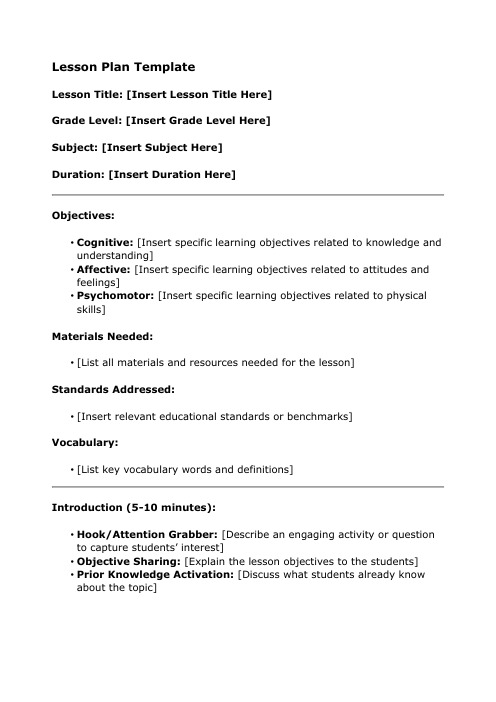
Lesson Plan TemplateLesson Title: [Insert Lesson Title Here]Grade Level: [Insert Grade Level Here]Subject: [Insert Subject Here]Duration: [Insert Duration Here]Objectives:Cognitive: [Insert specific learning objectives related to knowledge and understanding]Affective: [Insert specific learning objectives related to attitudes and feelings]Psychomotor: [Insert specific learning objectives related to physical skills]Materials Needed:[List all materials and resources needed for the lesson]Standards Addressed:[Insert relevant educational standards or benchmarks]Vocabulary:[List key vocabulary words and definitions]Introduction (5-10 minutes):Hook/Attention Grabber: [Describe an engaging activity or question to capture students’ interest]Objective Sharing: [Explain the lesson objectives to the students]Prior Knowledge Activation: [Discuss what students already know about the topic]• • • • • • • • •Instruction (15-20 minutes):Direct Instruction: [Provide detailed steps for teaching the content,including explanations, examples, and demonstrations]Guided Practice: [Describe activities where students practice new skills with teacher support]Check for Understanding: [List questions or formative assessments to gauge student comprehension]Independent Practice (10-15 minutes):[Describe activities where students practice skills independently]Closure (5-10 minutes):Summary: [Recap the main points of the lesson]Student Reflection: [Ask students to reflect on what they learned]Preview of Next Lesson: [Briefly introduce what will be covered in the next lesson]Assessment:Formative: [Describe how you will assess student understanding during the lesson]Summative: [Describe any end-of-lesson assessments, such as quizzes or projects]Differentiation:For Advanced Learners: [Describe how you will challenge advanced students]For Struggling Learners: [Describe how you will support students who need extra help]Extensions:[List additional activities or projects for students who finish early or want to explore the topic further]Reflection:[Space for teacher to reflect on the lesson’s effectiveness and areas for improvement]• • • • • • • • • • • • •Example Lesson PlanLesson Title: Introduction to PhotosynthesisGrade Level: 5th GradeSubject: ScienceDuration: 45 minutesObjectives:Cognitive: Students will understand the basic process ofphotosynthesis.Affective: Students will appreciate the importance of plants in the ecosystem.Psychomotor: Students will create a diagram of the photosynthesis process.Materials Needed:Whiteboard and markersChart paper and markersPhotosynthesis worksheetPlant samplesVideo on photosynthesisStandards Addressed:NGSS 5-LS1-1: Support an argument that plants get the materials they need for growth chiefly from air and water .Vocabulary:PhotosynthesisChlorophyllCarbon dioxideOxygenGlucose• • • • • • • • • • • • • •Introduction (5-10 minutes):Hook/Attention Grabber: Show a short video clip of plants growing in fast motion.Objective Sharing: Explain that today we will learn how plants make their own food through photosynthesis.Prior Knowledge Activation: Ask students what they know about how plants grow.Instruction (15-20 minutes):Direct Instruction: Explain the process of photosynthesis using a diagram on the whiteboard. Highlight the role of sunlight, water , and carbon dioxide.Guided Practice: Work through a photosynthesis worksheet as a class,filling in the blanks and labeling parts of the process.Check for Understanding: Ask students to explain the process in their own words and answer questions about the diagram.Independent Practice (10-15 minutes):Students will draw their own diagram of the photosynthesis process and label each part.Closure (5-10 minutes):Summary: Recap the main points of photosynthesis.Student Reflection: Ask students to share one new thing they learned about plants.Preview of Next Lesson: Introduce the next topic: the role of plants in the food chain.Assessment:Formative: Monitor student participation during guided practice and check for understanding.Summative: Review the diagrams students create for accuracy and completeness.Differentiation:For Advanced Learners: Provide additional reading material on the chemical equations involved in photosynthesis.• • • • • • • • • • • • •For Struggling Learners: Pair students with a buddy for the independent practice activity.Extensions:Research project on different types of plants and their photosynthesis processes.Reflection:[Teacher’s notes on what worked well and what could be improved for next time]• • •。
教案Lesson plan
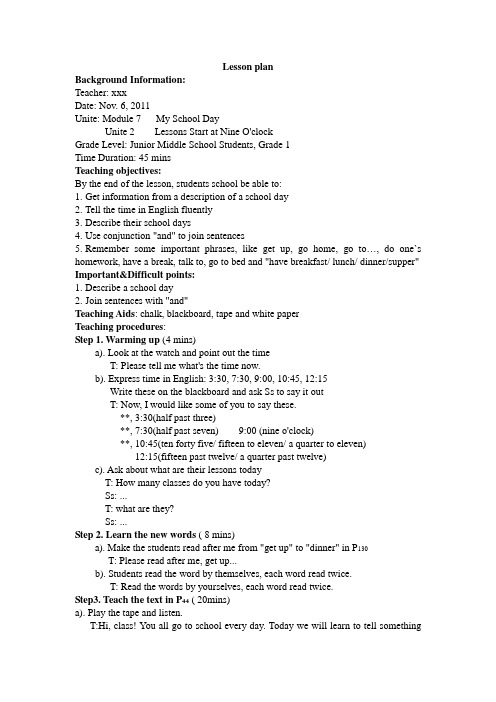
Lesson planBackground Information:Teacher: xxxDate: Nov. 6, 2011Unite: Module 7 My School DayUnite 2 Lessons Start at Nine O'clockGrade Level: Junior Middle School Students, Grade 1Time Duration: 45 minsTeaching objectives:By the end of the lesson, students school be able to:1.Get information from a description of a school day2.Tell the time in English fluently3.Describe their school dayse conjunction "and" to join sentences5.Remember some important phrases, like get up, go home, go to…, do one`s homework, have a break, talk to, go to bed and "have breakfast/ lunch/ dinner/supper" Important&Difficult points:1.Describe a school day2.Join sentences with "and"Teaching Aids: chalk, blackboard, tape and white paperTeaching procedures:Step 1. Warming up (4 mins)a). Look at the watch and point out the timeT: Please tell me what's the time now.b). Express time in English: 3:30, 7:30, 9:00, 10:45, 12:15Write these on the blackboard and ask Ss to say it outT: Now, I would like some of you to say these.**, 3:30(half past three)**, 7:30(half past seven) 9:00 (nine o'clock)**, 10:45(ten forty five/ fifteen to eleven/ a quarter to eleven)12:15(fifteen past twelve/ a quarter past twelve)c). Ask about what are their lessons todayT: How many classes do you have today?Ss: ...T: what are they?Ss: ...Step 2. Learn the new words ( 8 mins)a). Make the students read after me from "get up" to "dinner" in P130T: Please read after me, get up...b). Students read the word by themselves, each word read twice.T: Read the words by yourselves, each word read twice.Step3. Teach the text in P44 ( 20mins)a). Play the tape and listen.T:Hi, class! Y ou all go to school every day. Today we will learn to tell somethingabout your school day. Now turn to page 44. This is an email sent by Alex, in this email he tells us his school day, I will play the tape for you. But before listening, let guess what Alex do in the pictures in page 44.T: Now, let's listen to the tape carefully to see if you are right and correct the wrong ones.b). Play the tape again and ask the Ss to finish task 1 and 2T: listen again and try to put the pictures in order and finish exercise 2. And check the answers with your partner.c). Call back the answers from the whole classd). Let the Ss read the passages after me. And answer the following questions:T: read the passages after me, and then discuss with each others to find out the answers of following questions.(put paper 1 one the blackboard)1). When does Alex get up?2). When does Alex go to school?3). When do they have a break?4). When do they have lunch?5). When do the lessons start?6). When does Alex go to bed?e). Check the answer.f). Translate passage 1, passage 2 and passage 4, then ask Ss to translate the rest.The Chinese of the passages:1. 嗨,我是格里尔诺.阿里克斯。
LessonPlan英语课程计划.
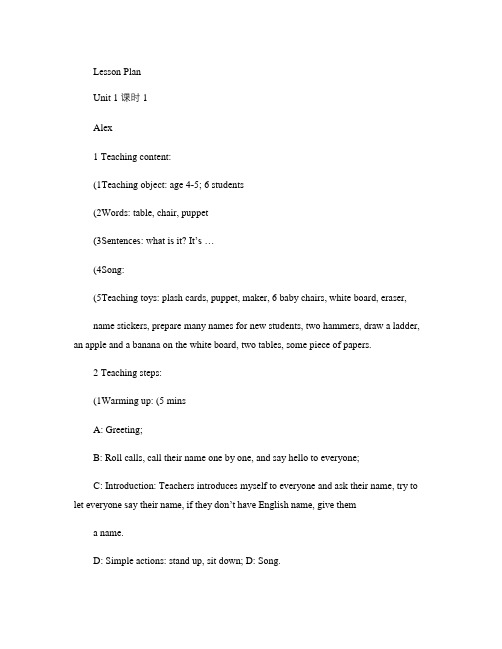
Lesson PlanUnit 1 课时1Alex1 Teaching content:(1Teaching object: age 4-5; 6 students(2Words: table, chair, puppet(3Sentences: what is it? It’s …(4Song:(5Teaching toys: plash cards, puppet, maker, 6 baby chairs, white board, eraser,name stickers, prepare many names for new students, two hammers, draw a ladder, an apple and a banana on the white board, two tables, some piece of papers.2 Teaching steps:(1Warming up: (5 minsA: Greeting;B: Roll calls, call their name one by one, and say hello to everyone;C: Introduction: Teachers introduces myself to everyone and ask their name, try to let everyone say their name, if they don’t have English name, give thema name.D: Simple actions: stand up, sit down; D: Song.(2Words presentation: (20 minsA: Words: chair, puppet, and table. Real object; flash cards; CDB: Practice for words: Together, show the flash cards one by one, loud and small sound and tone to say every word.Individual: by kissing, touching and kicking to say the word. Hammer gameGroup work: two groups, each team s students.Start single – Name – Rules – Game – The end singleSpread the flash cards on the floor, when the teacher says aword and they need to hit the word and say it. The winnercan be the teacher one time and say a word let the otherstudent hit it, besides; the winner group can have one stepup the ladder. The winner group can have two stars for eachone. Collect the flash cards and do the ends single.(10 minsC: Production: Check. Racing game; two groups. (10 minsStart single -- Name the gameRules: let a student do an example with the teacher; make two lines –the top two students hold the hammer before the teacher givethe single;When the teacher says a word the student goes and find it, andsay the word.The winner group can have two starts.Start – the end single(3Sentences presentation: (15 minsA: answer: listen to the CDB: practice: It’s …Individually: craw craw craw (game.Rules: place two tables end to end, make a line and they craw under the table from the top to the end, the teacher will waiting for them at the endof the table. The teacher says: “what is it?”T hen each kid can get a chanceto practice: It’s …Together: what is it? It’s …Group work: two groups. Keep going the ladder game.Now the students ask the teacher question. The group that louder than another one can have one step up,C: production: checkTwo teams: racing gameSingle – name – rulesRules: the teacher opposite to the students, when the teacher says goes, theyjump/craw/ hop/run to the teach er; the teacher says: “what is it?” the first one who can answer the question and jump/craw/… back to the line, they will win.Start – the end actionCommunication: five stepsRules: each student draw a picture (chair, table and puppet; the teacher ask a student do an example, the teacher says: “what is it?” the student look at the teacher’s picture and say the answer, then the student ask the teacher the question,, after that they change their picture and go to find others do the same thing; when they change one time they can get a poker. The winner could be the one have the most pokers.Start – endThe minutes breakThe second class (40 minsTeaching steps:(1Review “what is it, It’s …” (5 mins(2Letter A a B b (10 mins flash cards A a B b same hammer game.(3Hand out some pictures to the students: chair table puppet; trace A aB b. (when the students do the drawing things the teacher canreview again by individually (15 mins(4Wrap up (10mins: review all the stuff (5 mins;Line up, train game;Homework: tell their parentsGoodbye :( If some parents want to know their kids’ behavior you can let them wait after the class.。
LessonPlan教案

Lesson Plan 教案
Learning objectives學習目標:
Prior Knowledge & skills已有知識及技能:
教學活動及流程:
# 展示在教學活動中為照顧高能力/資優學生而調適的教學內容和策略。
學習評估:
Lesson Plan 教案
Learning objectives學習目標:
Prior Knowledge & skills已有知識及技能:
教學活動及流程:
#展示在教學活動中為照顧高能力/資優學生而調適的教學內容和策略。
學習評估:
Lesson Plan 教案
Learning objectives學習目標:
Prior Knowledge & skills已有知識及技能:
教學活動及流程:
香港進食失調康復會有限公司派員到校主講《瘦身文化面面觀》講座
全級進行
# 展示在教學活動中為照顧高能力/資優學生而調適的教學內容和策略。
學習評估:
Lesson Plan 教案
Learning objectives學習目標:
Prior Knowledge & skills已有知識及技能:
教學活動及流程:
#展示在教學活動中為照顧高能力/資優學生而調適的教學內容和策略。
學習評估:
Lesson Plan 教案
Learning objectives學習目標:
Prior Knowledge & skills已有知識及技能:
教學活動及流程:
#展示在教學活動中為照顧高能力/資優學生而調適的教學內容和策略。
學習評估:。
Lesson Planning 英语教案编写
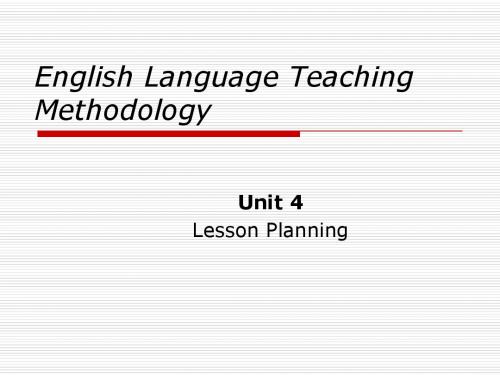
aims, objectives
How to achieve:
materials, activities, techniques, resources, etc.
True or False
( ) Experienced teachers do not need to do lesson planning. ( ) A lesson plan can be used for different classes in the same grade. ( )A lesson plan of the same textbook can be used year after year. ( ) A lesson plan is used flexibly in the classroom teaching.
English Language Teaching Methodology
Unit 4 Lesson Planning
Unit 4 Lesson Planning
1. 2. 3. 4. 5. Why is lesson planning important? Principles for good lesson planning Macro planning vs. micro planning Components of a lesson plan Sample lesson plans
Unit3LessonPlanning教案
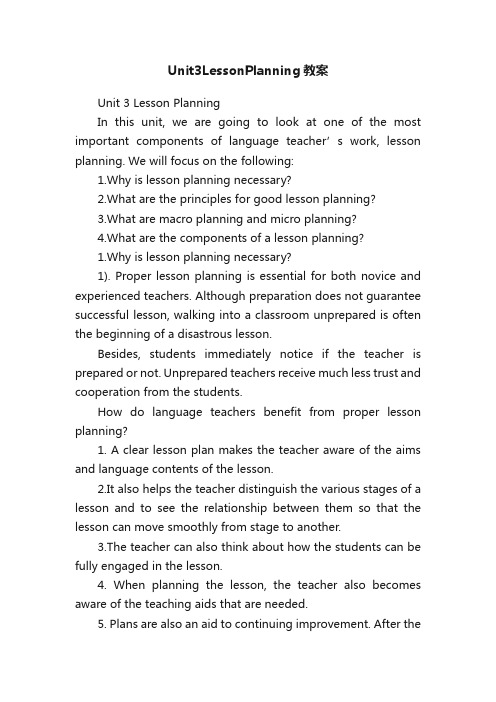
Unit3LessonPlanning教案Unit 3 Lesson PlanningIn this unit, we are going to look at one of the most important components of language teacher’s work, lesson planning. We will focus on the following:1.Why is lesson planning necessary?2.What are the principles for good lesson planning?3.What are macro planning and micro planning?4.What are the components of a lesson planning?1.Why is lesson planning necessary?1). Proper lesson planning is essential for both novice and experienced teachers. Although preparation does not guarantee successful lesson, walking into a classroom unprepared is often the beginning of a disastrous lesson.Besides, students immediately notice if the teacher is prepared or not. Unprepared teachers receive much less trust and cooperation from the students.How do language teachers benefit from proper lesson planning?1. A clear lesson plan makes the teacher aware of the aims and language contents of the lesson.2.It also helps the teacher distinguish the various stages of a lesson and to see the relationship between them so that the lesson can move smoothly from stage to another.3.The teacher can also think about how the students can be fully engaged in the lesson.4. When planning the lesson, the teacher also becomes aware of the teaching aids that are needed.5. Plans are also an aid to continuing improvement. After thelesson the teacher can add an evaluation to the plan, identifying those parts which went well and those which were less successful.2. Principles for good lesson planning1). V arietyIt means planning a number of different types of activities and where possible introducing students to a wide selection of materials so that learning is always interesting, motivating and never monotonous for the students.2). FlexibilityIt means planning to use a number of different methods and techniques rather than being a slave to one methodology. This will make teaching and learning more effective and more efficient.3). LearnabilityIt means the contents and tasks planned for the lesson should be within the learning capability of the students.4). LinkageIt means the stages and steps within each stage are planned in such a way that they somehow linked with one another. Language learning needs recycling and reinforcement.3. Macro planning vs. micro planningIdeally, lesson planning should be done at two levels: macro planning and micro planning. The former is planning over time, for instance, the planning for a month, a term, or the whole course. The latter is planning for a specific lesson, which usually lasts 40 or 50 minutes.Macro planning involves the following:A. knowing about the course: the teacher should know which language areas and language skills should be taught or practiced in the course, what materials and teaching aids are available, and what methods and techniques can be used.B. knowing about the institution: the teacher should know the institution’s arrangements regarding time, length, frequency of lessons, physical conditions of classrooms, and exam requirements.C. knowing about the learners: the teacher should acquire information about the students’ age range, sex ratio, social background, motivation, attitudes, interests, learning needs and other individual factors.D. knowing about the syllabus: the teacher should be clear about the purposes, requirements and targets specified in the syllabus.(National English Curriculum Standard)Much of macro planning is done prior to the commencement of course. However, macro planning is job that never really the ends until the end the course.Macro planning provides guidance for language teachers. However, most teachers have more confidence if they have kind of written plan for each lesson they teach.The advantage of a concrete teaching plan is that teachers can follow it in the class and check what they have done. This plan will be basis of a record of what has been covered in class, and will make it easier to make achievement teats later. The teaching plans will be good records for the entire course.4. Components of a lesson plan1). Teaching aims2). Language contents and skills3). Teaching stages and procedures1). Teaching aimsThe first in lesson planning is to decide the aims of a lesson, which include what language components to present, whatcommunicative skills to practice, what activities to conduct and what materials and teaching aids to be used.2). Language contents and skillsIn language teaching, it is very important for the teacher to know exactly what language contents will be taught and what language skills will be practiced in the lesson. Language contents mean structures (grammar), vocabulary, functions, topics, and so on. Language skills are L, S, R and W.3). Teaching stages and proceduresAt the presentation stage, the teacher introduces new vocabulary and grammatical structures with reference to their contextualized use.At the practice stage, the lesson moves from controlled practice to the guided practice and further to the exploitation of the texts when necessary.At the production stage, the students are encouraged to use what they have learned and practiced to perform communicative tasks. At this last stage, the focus is on meaning rather than formal accuracy.Another model is pre-reading, while-reading, post-reading.This model is also often applied in listening lessons, which have pre-listening, while-listening, and post-listening stages.In this model, the pre- stage involves preparation work, such as setting the scene (描述背景), warming up, or providing key information( such as key words).The while- stage involve activities or tasks that the students must perform while they are reading or listening.The post- stage provides a chance for students to obtain feedback on the performance at the while- stage. This may involve follow-up activities, in which students relate what theyhave read or heard to their own life and use the language spontaneously.Components of a lesson plan1. Contents2. Aims/Teaching aims/objectives3. Language focus4. Aids/Teaching aidsTeaching procedure(s)Homework/AssignmentsLayout of the blackboard。
Lesson Plan英语教案一般现在时教学设计

Lesson PlanTeaching the present simple tense is one of the first, and most important tasks when teaching beginners. It's a good idea to teach the present simple of the verb 'to be' to begin with, and introduce simple adjectives to help students expand their understanding of the verb 'to be'. After English learners are comfortable with the present and past forms of the verb 'to be', teaching the present simple and past simple will be much easier.5 Steps for Introducing the Present SimpleStart by Modeling the Present SimpleMost English learners are false beginners. In other words, they have already studied English at some point. Begin teaching the present simply by stating some of your routines:I get up at six-thirty in the morning.I teach at the Portland English School.I have lunch at one o'clock.Students will recognize most of these verbs. Model some questions for the students as well. At this point, it's a good idea to ask yourself a question and provide the answer.When do you have dinner? - I have dinner at six o'clock.When do you come to school? - I come to school at two o'clock.Where do you live? - I live in Portland.Continue by asking students the same questions. Students will be able to follow your lead and answer appropriately.Introduce the Third Person SingularOnce the students are comfortable speaking about their own basic daily activities, introduce the third person singular for 'he' and 'she' which willprove the most difficult for students. Again, model the present simple third person ending in 's' for the students.When does Mary have dinner? - She has dinner at six o'clock.When does John come to school? - He comes to school at twoo'clock.Where does she live? - He lives in Portland.Ask each student a question and ask another for a reply, creating a chain of questions and answers changing from 'you' to 'he' and 'she'. This will help students memorize this crucial difference.Where do you live? - (Student) I live in Portland.Where does he live? - (Student) He lives in Portland.Introduce the NegativeIntroduce the negative form of the present simple in the same manner as above. Remember to continually model the form to the students and immediately encourage a similar answer.Does Anne live in Seattle? - No, she doesn't live in Seattle. Shelives in Portland.Do you study French? - No, you don't study French. You studyEnglish.Introduce QuestionsUp to this point, students have been answering questions so they should be familiar with the form. Make sure to point out the difference between 'yes/no' questions and information questions. Start with 'yes/no' questions encouraging students to answer in the short form.Do you work every day? - Yes, I do./No, I don't.Do they live in Portland? - Yes, they do./No, they don't.Does she study English? - Yes, she does/No, she doesn't.Once students are comfortable with short 'yes/no' questions, move on to information questions. Make sure to vary the subjects up to help students become familiar with the tendency to drop the 's'.Where do you live? - I live in Seattle.When do you get up in the morning? - I get up at seven o'clock.Where does she go to school? - She goes to school at theUniversity of Washington.Discuss Important Time WordsOnce students become comfortable with the present simple, introduce important time words such as 'everyday' and adverbs of frequency (usually, sometimes, rarely, etc.). Contrast these with common time words used in the present continuous such as 'now', 'at the moment', etc.She usually takes the bus to work. Today, she is driving.My friend sometimes goes out for dinner. At the moment, he'scooking dinner at home.Jennifer rarely talks to strangers. Right now, she's talking to afriend.3 Strategies for Practicing the Present Simple Explaining the Present Simple on the BoardStudents will now recognize the present simple tense and be able to respond to simple questions. It's time to introduce the grammar. Use a present simple tense timeline on the board to stress the fact that this tense is used to express routines. I also like to use simple charts showing the underlying structure of this tense.Comprehension ActivitiesOnce you have introduced the tense and used the whiteboard to explain forms, continue teaching the present simple tense through activities which use the present simple in context.Continued Activity PracticeStudents have learned to recognize the present simple, as well as understand the form in comprehension activities. It's time to continue by having students use the present simple to describe their own lives inboth spoken and written form. This detailed lesson on daily routines will help you continue the practice.Expected ProblemsHere are the most common challenges for students when using the present simple:•Confusing with the present continuous for actions occurring at the moment of speaking.•Use of 's' in the third person.•Auxiliary verb usage in the question and negative form, but NOT in the positive form.•Placement of adverbs of frequency.。
英语教案Lesson plan

Lesson planBackground information:Students: 60 Junior high school students, Grade1Lesson duration: 45 minsTeaching objectives:By the end of the lesson, students should be able to:1.Say in English the plurals of Nouns.2.Ask and answer questions about the Nouns.e the interview Strategies to ask information and take notes.4. learn to be a good listener and brave to ask questions in English. Teaching contents: the classification of Nouns, the plurals of Nouns map---maps box---boxes sheep---shee p…Wha t’s this? ---This is a pianoHow many books are there in the desk? ---Ten books.Teaching aids: blackboard, chalk, PPT, picturesTeaching procedures:Step1. Review (10 mins)a) Students write down the Nouns they know.b) Students try to guess the plurals of the Nouns.c) Teacher summarizes, and writes the words on board.Step2.Learn the related information about Nouns: the classification of Nouns, the plurals of Nouns (20 mins)a) Use a chart to show the students the classification of Nouns.b) Learn the plurals of Nouns.c) do some exercises about Nouns.Steps3.More practice (15 mins)a) Work in pairs, and ask and answer the questions related to Nouns. Use the structure: what’s this?--- This i s…/How many are there on the desk?--- They ar e…b) V olunteers to present the result.Homework: Make some sentences and dialogues about Nouns learned in class.Reflection: (to be written immediately after the lesson).。
(完整word版)lesson plan
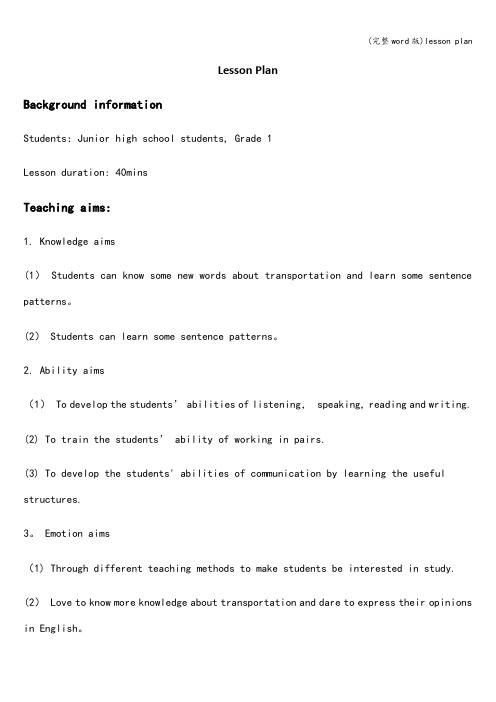
Lesson PlanBackground informationStudents:Junior high school students, Grade 1Lesson duration: 40minsTeaching aims:1. Knowledge aims(1) Students can know some new words about transportation and learn some sentence patterns。
(2) Students can learn some sentence patterns。
2. Ability aims(1)To develop the students’ abilities of listening, speaking, reading and writing.(2) To train the students’ ability of working in pairs.(3) To develop the students' abilities of communication by learning the useful structures.3。
Emotion aims(1) Through different teaching methods to make students be interested in study. (2) Love to know more knowledge about transportation and dare to express their opinions in English。
(3) Encourage the students to be more creative and try to make contributions to making new inventions in the future。
Lesson Plan英文版教案模板
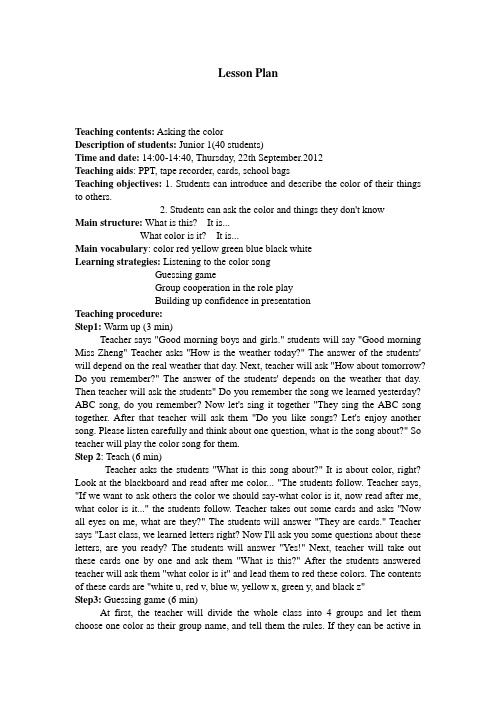
Lesson PlanTeaching contents: Asking the colorDescription of students: Junior 1(40 students)Time and date: 14:00-14:40, Thursday, 22th September.2012Teaching aids: PPT, tape recorder, cards, school bagsTeaching objectives: 1. Students can introduce and describe the color of their things to others.2. Students can ask the color and things they don't knowMain structure: What is this? It is...What color is it? It is...Main vocabulary: color red yellow green blue black whiteLearning strategies: Listening to the color songGuessing gameGroup cooperation in the role playBuilding up confidence in presentationTeaching procedure:Step1: Warm up (3 min)Teacher says "Good morning boys and girls." students will say "Good morning Miss Zheng" Teacher asks "How is the weather today?" The answer of the students' will depend on the real weather that day. Next, teacher will ask "How about tomorrow? Do you remember?" The answer of the students' depends on the weather that day. Then teacher will ask the students" Do you remember the song we learned yesterday? ABC song, do you remember? Now let's sing it together "They sing the ABC song together. After that teacher will ask them "Do you like songs? Let's enjoy another song. Please listen carefully and think about one question, what is the song about?" So teacher will play the color song for them.Step 2: Teach (6 min)Teacher asks the students "What is this song about?" It is about color, right? Look at the blackboard and read after me color... "The students follow. Teacher says, "If we want to ask others the color we should say-what color is it, now read after me, what color is it..." the students follow. Teacher takes out some cards and asks "Now all eyes on me, what are they?" The students will answer "They are cards." Teacher says "Last class, we learned letters right? Now I'll ask you some questions about these letters, are you ready? The students will answer "Yes!" Next, teacher will take out these cards one by one and ask them "What is this?" After the students answered teacher will ask them "what color is it" and lead them to red these colors. The contents of these cards are "white u, red v, blue w, yellow x, green y, and black z"Step3: Guessing game (6 min)At first, the teacher will divide the whole class into 4 groups and let them choose one color as their group name, and tell them the rules. If they can be active inthese games they can get stars, and the group which get the most stars is the winner.Then Teacher will say "now let's play a guessing game. Look at the picture." Teacher will point the picture and show them "This is a piece of cloth, and behind the cloth there is something. I leave some parts of it out, so please base on these parts to guess what it is and what color it is, understand?...Let's begin..." Then the teacher will ask the whole class, or just one student, or let two students ask each other, or let the students ask the teacher. The questions are "what is this? What color is it?"The contents of these pictures are "red apple, yellow banana, green tree, blue sky, white clouds, and black Chinese ink". These students who asked or answered questions in the game can get stars for their team.Step4: Counting color game (2 min)Teacher will show the students a picture of Olympic rings, and let the students to count how many colors are there in the picture and read them out. If someone can count them out and say it out accurately he or she can get one star for his or her group. Step5: Make conversations (9 min)Teacher will let the students take out their school bags and introduce their things to their group members, they can ask any thing about the things, but they must ask the color (5 min). Then they should show their conversation to the whole class (4 min).Step6: Write a passage (13 min)The teacher will let the students to think about their bed room, and write a passage to describe their bed room and those things in their bedroom (9min).Then choose some students read their passage for the whole class (4 min). Step7: Homework (1 min)Draw a picture of the things you like and paint the color you like most on it. ReflectionStrong points:Smiles sweet, good pronunciation, natural transition, logical organization.Shortcomings:Teaching contents looks not so rich, those cards can be better, rewarding system can be more attractive and interesting.。
LESSON PLAN教案

Lesson PlanTeaching contents:PEP Primary English Grade4 Unit 2 Part A Let’s spell Analysis on teaching material:本课为小学四年级的语音教学,重点是学习i在开音节里面的发音,考虑到PEP小学英语三年级下册已经学过i在闭音节里的发音,因此在教学中,利用Bill和Mike为主线人物,通过复习i在闭音节的发音来引出新知i在开音节的发音,并且结合five,kite,nine,like,rice等单词,通过拆和拼的方式进行语音教学,从中不断渗透拼读方法,并让学生不断对比和区别i在开闭音节的发音,使学生能够掌握拼读规律与技巧,以及在阅读情境语句中体会单词的音,形,意和语言的无穷魅力。
Teaching aims:1.能够感知并归纳i-e在单词中的发音规则。
2.能够读出符合i-e发音规则的单词。
3.能够根据单词的读音拼写出符合i-e发音规则的单词。
Teaching key points:1.掌握元音字母i在开音节的发音。
2.能够正确说出字母i在开音节中的发音,并且能够根据发音规律拼读学过的语音句子。
Teaching difficult point:能够正确说出字母i在开音节中的发音,并且能够根据发音规则,拼读出单词以及句子。
Teaching steps:(40mins)Step 1 Warming Up1. GreetingsT: Good morning, boys and girls! (Teacher is smiling!)Ss: Good morning, teacher!T: Now you will enjoy a song: Smart hand.Ss: sing song(To review the letter sound learnt before and make Ss focus on the sound of letters)1。
(1)Lesson plan教案A New Term lesson one 第一课
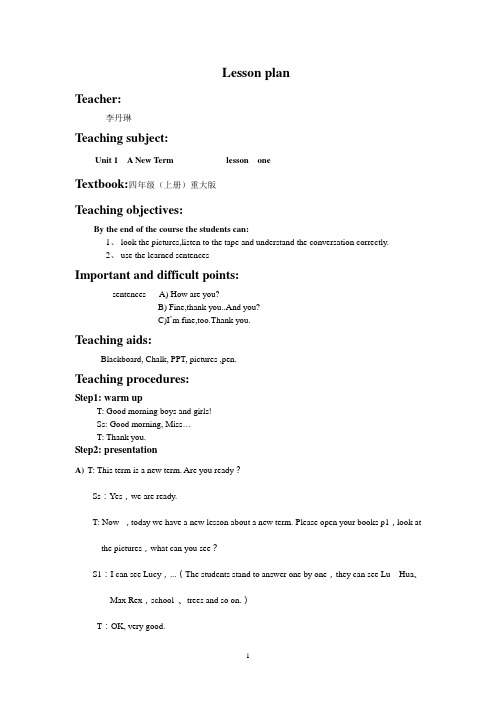
Lesson planTeacher:李丹琳Teaching subject:Unit 1 A New T erm lesson oneTextbook:四年级(上册)重大版Teaching objectives:By the end of the course the students can:1、look the pictures,listen to the tape and understand the conversation correctly.2、use the learned sentencesImportant and difficult points:sentences A) How are you?B) Fine,thank you..And you?C)I’m fine,too.Thank you.Teaching aids:Blackboard, Chalk, PPT, pictures ,pen.Teaching procedures:Step1: warm upT: Good morning boys and girls!Ss: Good morning, Miss…T: Thank you.Step2: presentationA)T: This term is a new term. Are you ready?Ss:Y es,we are ready.T: Now ,today we have a new lesson about a new term. Please open your books p1,look at the pictures,what can you see?S1:I can see Lucy,...(The students stand to answer one by one,they can see Lu Hua、Max Rex,school 、trees and so on.)T:OK, very good.B) Listen to the tape .Then read after it. T eacher can guide.Step3: controlled practicePractice: A Setences practicea)How are you?b)Fine,thank you..And you? c)I’m fine,too.Thank you.d)Lu Hua,I have a new schoolbag.Look! e)How beautiful! f)Thank you.Practice: B Sub-role of the reading1)、Teacher: Hi Lu Hua! How are you?…Pupils: …How beautiful!2)、Team1、2:Hi Lu Hua! How are you?…Team3、4:…How beautiful!3)、S1:Hi Lu Hua! How are you?S2:…How beautiful!Practice:C Group activitiesFirst, let four students into one group,and prctice themselves.Then ask some groupsto show.Step4: homework1)Listening and reading the page one 5 times.2)Copy the correct format for writing letters Hh-Nn, each one row.Blackboard design:Unit 1 A New Term Lesson 1T: How are you?S: Fine,thank you.And you?T: I’m fine,too.Thank you.。
lesson plan教学设计

lesson plan教学设计Lesson plan teaching designlesson plan教学设计前言:小泰温馨提醒,英语作为在许多国际组织或者会议上都是必需语言,几乎所有学校选择英语作为其主要或唯一的外语必修课。
英语教学涉及多种专业理论知识,包括语言学、第二语言习得、词汇学、句法学、文体学、语料库理论、认知心理学等内容。
本教案根据英语课程标准的要求和针对教学对象是初中生群体的特点,将教学诸要素有序安排,确定合适的教学方案的设想和计划、并以启迪发展学生智力为根本目的。
便于学习和使用,本文下载后内容可随意修改调整及打印。
Lesson planDate:Dec.3 Period:oneClass:four Grade:oneTeaching materials: Text of lesson 49English Book I p61Teaching objectives: Help the students(1)learn the new words and be able to make sentences with then .(2)learn the test and be able to describe the colours in English .Type or lesson:Comphrehensive lesson .Teaching tools:a tape-recorder ,some pictures and a small blackboard .Organization of class:Ⅰ.Greeting students ready for class .1、Greeting students to order .2、Exchange of greeting with students .3、Ask the students on duty the following questions:T: Is everyone here ? S:T: Who is on duty today? S:T:Whats the weather like today?S:4、Telling students the teaching contents:Ⅱ.review and cheek-up .Ask students to answer the following questions with cards:T: whats this in English?S: Its……T:Whats that ?S: Its……T:Is this(that) a(an)……?S:Yes , it is ./No, it isn t .Ⅲ. Presentation of the new materials:1、Teching the following new words with a small blackboard .1)What colour is it ?(Teacher point to thepictures on the small blackboard)Itsblack/red/white/green/yellow/blue/purple/brown/orange/gre y.(students read out aloud)2)Whats colour is it ? (Teacher point to the classroom in the picture)Its…(red) . (students read aloud)2、Teach the text:1)Put up some pictures and ask students to listento the recording of the text while looking at the picture.(again and again)2)Ask the students some questions to cheek them .①Whats this (that) ?②Is this (that) a car ?③What colour is it ?④Its…(black) . Its a …(black) car .3)Explain some language points:①There is a car on the hill in the picture . (Explain why use "on" instead of "in")②A:what colour is it? B:Its black. Its a black car. (Extlain "black" and " a black car "the use of sentences) .Ⅳ. Reinforcement :1、Reading the text after the recording and theteacher gives some guideline to the pronuncition and intonation of reading the text .2、Ask students to read the text .3、Ask students to give some questions on the pictures and give answer.4、Play a game use pictures ( T : Act it.Ask students do it like this )Ⅴ. Summary:Today were learned some new words and the text please pay attention to those words in the text. (pointing to some important points)Ⅵ. Design for exercises:1、Homework:1)Revise the dialogues in lesson 49 .2)Write the new words .3)Finish the workbook esercises. Do Ex 2,3 in the exercise book .2、Additional exercises :A)词组互译:1、一只红色的风筝2、一朵黄色的花3、一辆蓝色的小汽车4、一只黑色的猫5、一只白色的鸟6、一个绿色的苹果B)Fill in the blank:A:Whats over there?B: ?A:Over there, the hill.B: a car.A:is it ?B:Its red. Its ared .A:Is a car , too ?B: , it is .A:What colour is it ?B:Its . Its a black car.-------- Designed By JinTai College ---------。
教师备课:Unit30第118课LessonPlan分析教案

教师备课是教学中非常重要的一环,教师在备课时需要对教育教学理论、知识技能、教材课程等方面进行深入分析,设计出科学合理的课程教案,提高教学质量,实现教育教学目标。
本文将以教材Unit 30第118课Lesson Plan为例,深入剖析教案设计过程,并探究教育教学的精髓所在。
一、教案背景介绍本节课的教学内容是Unit 30第118课Lesson Plan,该教案属于外语教育教学范畴,主要针对初中生进行教学。
本节课的学习目标是帮助学生学会根据自己的兴趣爱好制定周末活动计划,并掌握表示未来计划的相关语言表达方式。
二、教案分析1.教学目标分析本节课的教学目标主要分为两个方面,一是明确学科知识目标,即学生需要学会如何制定周末活动计划,并掌握表达及交流的相关语言表达方式。
同时,其次是确定实践能力目标,即学生需要培养自己制定计划的能力,提高自主学习自主生活技能。
2.教学内容分析教师需要首先介绍本节课所要学习的单位,即制定计划的基本步骤。
在每个步骤中,教师需要让学生针对周末活动列举出足够的活动选择,分别涉及体育运动、文艺活动等不同类型的活动内容,让学生能够了解不同活动的特点,并根据自己的兴趣爱好进行选择。
同时,个人兴趣爱好的介绍和分析也是必不可少的一环。
3.教学模式分析本节课采用任务型教学模式,通过给学生一定的任务,让学生自主思考、自主探究,从而达到学习的目的。
通过在团队中交流、合作,学生不断地互相交流,互相分享信息,提高了学习效果和学习水平。
4.教学方法分析本节课采用了多种教学方法,包括思维导图法、自主探究法、合作学习法、情景模拟法等,这些教学方法多样化,能够更好地满足学生的学习需求,更好地开发学生学习潜力。
5.教学评价分析本节课的教学评价的主要内容包括小组讨论,课堂练习和作业评价。
通过小组讨论,学生能够充分表达自己的见解,通过课堂练习,学生能够更好地巩固所学知识。
同时,作业评价也对于学生的自主学习、自主思考起到很好的推动作用。
- 1、下载文档前请自行甄别文档内容的完整性,平台不提供额外的编辑、内容补充、找答案等附加服务。
- 2、"仅部分预览"的文档,不可在线预览部分如存在完整性等问题,可反馈申请退款(可完整预览的文档不适用该条件!)。
- 3、如文档侵犯您的权益,请联系客服反馈,我们会尽快为您处理(人工客服工作时间:9:00-18:30)。
Lesson planUnit 5 Traveling AbroadPeriod 1 Warming-up and readingTime: 45 minutesThe number of students: 50The grade of students: grade two in high school1.The analysis of teaching materials:This unit formsa part of high school English teaching material, Student’s Book 7. This unit can be divided into three parts: warming-up, reading, listening about language. Its main topic is traveling abroad and it contains two reading materials, studying in foreign country and traveling in foreign country. Today,we will learn the first part, studying in a foreign country. In this unit, it tells students what problems they will meet in foreign countries and how to deal with these problems. Also, it introduces the benefits and difficulties of studying abroad through the story of Xie lei.2.The analysis of students:As high school students, they have learned English for several years and they have a basic command of English. Students will be interested with a certain topic easily, such as traveling, sports healthy life and so on, which adapts to their physical and psychological characteristics. Additionally, students are weak in English speaking, so in my class, I will design some questions and activities for them to practice their pronunciation.3.Teaching aims:Knowledge aim:a)Students will learn about Xie L ei’s school life in London.b)Students will learn new words and phrases including lecture, academic,comfort, requirement, acknowledge, preparation, contradict, occupy,recommend, substitute.Ability aim:a)Students will be able to use the new words about traveling abroad todescribe the life in foreign countries.b)Students will be able to think of their own way to deal with the possibleproblems of living abroad.c)Students will be able to know how to read the news report and get themain idea by finding the key information about what, when, why, whereand who.Emotion aim:a)Students will be more interested in traveling or studying abroad.b)Students can overcome the difficulties in study and life after readingXie Lei’s story.Learning strategy aim:a)Students will learn about the characteristics of the news report and getthe main idea by finding the main words, who, when, where, why,what.Culture aim:a)Students will gain more knowledge about the lifestyle and the weatherfeature in London.2.Key point:a)Learning the new words and phrases about traveling abroad and knowtheir meanings, such as requirement, acknowledge, preparation, fit in.b)Learning about the benefits and difficulties of studying abroad.3.Difficult point:a)Grasping the ability to skim and scan the text and the ability tosummarize the main idea of each paragraph. It requires students tosummarize the main idea according to find the key information aboutwhat, when, why, who, where.b)Learning the basic structure of emphatic sentence and how to use it. Itrequires students to be able to use it in the composition.4.Teaching aids:Power Point, a blackboard, some chalk, a tape recorder5.Teaching methods:Task-based language teaching6.Teaching procedure:Step1 Lead-in (4 minutes)At first,the teacher will ask students a question,if you have a chance to goabroad in the world, which country would you like to go?Why? Fifteen seconds later, the teacher will choose two students to tell their answers. After hearing these answers, the teacher will show some beautiful pictures of different countries to attract students’attention, such as Statue of Liberty, Sydney Opera House, Eiffel Tower and so on(5 slides)and next the teacher will ask students whether they want to go abroad to have a further study or not.Step2pre -reading(6minutes)Nowadays, more and more students wants to go abroad to have a further study. What are the advantages and disadvantages of studying abroad? Then the teacher will ask students to discuss in the four-people group.Suggested answers:T:”Youare going to read a newspaper article about aChinese student who goes to study in England. What do you think she will find differences from studying at a Chinese school/university? ”Step3 listening and fast reading (5minutes)1. Listen to the tape and find the answers to the following questions.1)Who is the main character?2)Will she overcome difficulties at last? Who helps her?3)What is Xie Lei in England for? How long has she been in England?2. True or False.a.When Xie Lei went to New York, she felt very excited and relaxed.b. Xie Lei came to the university to complete a science qualification.c. Xie Lei lives in the student accommodation.d. Xie Lei found the preparation course was very easy to learn at first.e.Xie Lei’s tutor helped her a lot in her study.Step4 detailed reading (12minutes)1.Summarize the main idea of the passage (the teacher will give students three minutes to skim the whole text and summarize the main idea) Suggested answer:The text mainly tells us a Chinese student named Xie Lei is studying at an English university, which introduces us her study life there and how she solved the difficulties she faced.2. Put the events into order_3__The difficulties Xie Lei met while living in London;_7__The newspaper will follow Xie Lei’s progress in later editions._2__The general introduction to Xie Lei and her study;_1__The advantages that Xie Lei gained while living with a host family._6__Xie Lei is now getting along well and is living an active life._4__ Xie Lei, a Chinese girl, is studying in a foreign country--London._5__Xie Lei is getting used to the Western University’s way of learning.3.Answer questions( The teacher will invite four volunteers to answer the four questions)1)Why is she doing a preparation course first?2)What are some of difficulties she faced when she first came to England?3)Why does Xie Lei have such a decision that she would like to board with ahost family while studying in England?4) How does Xie Lei try to get used to the new social life in England?Step5new words(8minutes)Firstly, the teacher will ask students to find out the new words in the first two paragraphs when they are reading it. Next, the teacher will check the new words that students find in the two paragraphs. Then the teacher will explain its meaning in the text and he will also expand its relevant phrases.For example:Step6 text analysis (9minutes)The teacher will write the example of emphatic sentence in the blackboard and tell students what an emphatic sentence is and then the teacher will ask students to make other sentences according to the sentence in the blackboard. Next, students will finish four single-choice questions about this grammar point in the PowerPoint. (强调句详情在幻灯片上可见)课文原句: It’s not just study that’s difficult.It is/ was + 被强调部分(通常是主语、宾语或状语)+ that/ who(当强调主语且主语指人)+ 其他部分。
